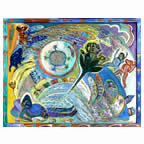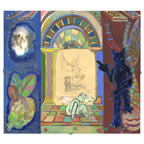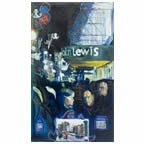TH. We meet three or four times a month, usually on Sunday morning, for about two hours, when we have conversations about painting - it’s hard to say whether as friends, or as sparring partners! Perhaps we should carry on in the same vein this evening? Can I start by asking when the Indian imagery first appeared in your work,  and did you welcome it?
and did you welcome it?
PG-C. I had reached a point where I wasn’t able to get excited enough by painting directly from life which was a crisis for me. But I had no idea where it was going. At the time, if somebody had said you will be painting angels, I’d have been appalled.
You’ve mentioned that the angels developed from a previous group of paintings, because you needed something to direct the eye upwards and then downwards, andone way of doing it was by having something in the picture that could hover.
Yes, but it suggested itself through painting, and that’s the crucial point. I certainly didn’t want angels, and equally I didn’t want Indian things to come into the painting, and I didn’t want the demons either. It’s always a technical reason that compels their presence in the work and there’s no narrative reason for putting them there. If I could make a painting with a bowl of flowers and a nice landscape behind and make it sufficiently charged then of course I’d do that. I don’t set out with a set of preconceived images. What’s important for me is the way the forms work, and when nothing happens a crisis occurs that causes some new aspect of imagery to come in. But even though my paintings are not usually about looking at things any more, most of them still have a perceptual element, whether it’s a glimpse of the city or a person. That perceptual aspect is still with me; I haven’t completely lost sight of that.
But when you paint a hand it doesn’t look like a perceptual hand.
 Some years ago I had painted a series of figures that were of people walking and I’d realized I was painting something in life that couldn’t be; it was a moving image and it couldn’t be captured, it couldn’t be recorded by a camera, it was like an explosion and I had to find some container for the figure to go into. That really was the beginning of the change I think, more than the angels.
Some years ago I had painted a series of figures that were of people walking and I’d realized I was painting something in life that couldn’t be; it was a moving image and it couldn’t be captured, it couldn’t be recorded by a camera, it was like an explosion and I had to find some container for the figure to go into. That really was the beginning of the change I think, more than the angels.
Would you be very resistant to the idea that there’s a specificity about the Indian influx in your work; you know, this half Indian guy who suddenly discovers his inheritance.
It’s very difficult. What I would say is that I was born in India and I am Indian but equally there has been Ethiopian imagery in the work and I’m not Ethiopian. The thing with Indian imagery is that it allows me to use very high-keyed colours which can be manipulated at will by me. I can make my colour relations as extreme or as crazy as I want them, and make it seem plausible; I can make a figure that’s made out of red, green and blue which I couldn’t if it was a straightforward scene of London. And Indian art has a different set of rhythms and it doesn’t have gravity, so I can do  different things from European art, something that hasn’t been seen before.
different things from European art, something that hasn’t been seen before.
There has of course been an enormous shift in your work with various phases of transition. But it happened long enough ago for you to have some perspective on it. One can’t entirely remain in a state of unconsciousness about these things.
The way I paint now I can deal, for instance, with aspects of colour density and translucency and things disappearing, more than I could before, which is a gain. But I’m still involved in trying to combine bits of something seen with something that is completely imaginative in order to get closer to my kind of reality.
Anyone who is painting straightforward linear descriptive painting today is up against it. Even in television and in film we now see four or five stories being told simultaneously, it’s just normal, and for painting not to be part of that would be like living in the past.
You seem to be saying that complexity of image is a given, or even that multi-layered imagery is an imperative. But some of the artists you most admire, like Bacon, have centred images.
Much as I admire Bacon, for me it’s not the way forward. No one else is doing what I’m doing and no one else can find answers for my questions. I haven’t seen a contemporary exhibition where I suddenly thought: yes it’s possible for straightforward linear, descriptive painting to be once more  really exciting.
really exciting.
‘Down Deep’, is a particularly complex and layered painting.
I wanted this painting to be something you could be in front of and images would come and go as you look at it. So in that way the structure of the painting is not like an orthodox painting, it can only be read slowly by discovering the various layers.
You’ve mentioned weightlessness but I don’t think that you want it to be completely free-floating like
a Polke?
Or a Kandinsky. No, I certainly don’t want that.
And more than that, it’s almost as though the accumulation of years is being brought into your pictures, it’s as if you’re building your life and your work and putting them together. It’s very rare that you pull a picture off in one go; you change the same picture over and over again, sometimes over a very long period.
 I find it extraordinary that I can do something that seems finished, and then a year or three years later suddenly I see something that needs to be changed. Why didn’t I see that at the time? And then five years later I see something else! That thing you hear about a painting never being finished, I’m experiencing it more and more. I don’t think it’s a good thing, but a painting can go on and on making demands.
I find it extraordinary that I can do something that seems finished, and then a year or three years later suddenly I see something that needs to be changed. Why didn’t I see that at the time? And then five years later I see something else! That thing you hear about a painting never being finished, I’m experiencing it more and more. I don’t think it’s a good thing, but a painting can go on and on making demands.
Do you think we should be taking pictures away from you?
No. I’ve probably destroyed one or two things that I shouldn’t have, but on the whole it’s no great loss. It’s annoying to re-paint something and end up with something worse, but what can you do? You’ve got to try it.
What one wants to avoid is contrivances.
Well, contrivance is the death of it. You have to be in a suitable state of mind to work; people don’t talk about that because it’s very hard to describe but it’s something you can’t discount. One mustn’t make a cult of this, but somehow, it comes to you when it wants to whether or not you want it. But you have to be ready to receive it.
Humour is a big factor now; it’s in the paintings, and in the titles.
Yes, humour has kind of crept in. I don’t know quite how it got in, but it did, and once it started occurring I didn’t edit it out. Because I wanted to see where it would go. The world we are in is a difficult and polluted place and you need humour to relieve the strain. After all, Hell isn’t in the afterlife anymore, it’s right here now and the damned ones are the ones who feel.
In one sense, though, you’re bringing back childhood images and maybe that’s a factor in the Indian thing rising up.
Childhood imagery is very important and childhood colours are imprinted in the mind and it’s true to say that often you can only release these colours forty or fifty years later. You can suddenly find a way of bringing a colour through and it’s the same with the rhythms; one way of painting will allow it and another way will not.
Obviously the other area is Dream. Not literally, because you don’t paint actual dreams, but the figure of
The Dreamer is implicit all the time.
 Yes, that has been with me a long time because it’s something that allows me to do things, whichdefy gravity and get away with it. You can say it’s a dream image, but it’s not to be confused with Jung or Krishna or other religious imagery which I don’t want to know about. If I knew more about it I’d have to make choices about imagery, anecdotal choices, rather than for the sake of the painting. The painting must always dictate, I want to follow that; I want the painting to instruct me during the making of it.
Yes, that has been with me a long time because it’s something that allows me to do things, whichdefy gravity and get away with it. You can say it’s a dream image, but it’s not to be confused with Jung or Krishna or other religious imagery which I don’t want to know about. If I knew more about it I’d have to make choices about imagery, anecdotal choices, rather than for the sake of the painting. The painting must always dictate, I want to follow that; I want the painting to instruct me during the making of it.
Yet you certainly do respond to medieval art, which is an imagery of religion.
There are icons I think are wonderful because art is about belief and the great religious images have the power to convince. All painting is to do with belief or faith of one kind or another. I think the reason why cave paintings still seem alive is because the artist was able to blow life into them. Everything you do is basically about finding some way of channeling your electricity into the work. Religious subject matter is also very specific, you can name it, and I think in painting you need to name the elements. That doesn’t mean I need to know what they mean. There’s a Rembrandt self portrait I was looking at the other day and it has skin, eyes looking at you, hair, white collar,black tunic and these are the elements but they are there to interact and set  each other off.
each other off.
Do you ever look at your work and think that it could be more monstrous? Compared to Bosch your demons aren’t so grotesque as they might be. There was a time when I thought your work might embody Despair. But funnily enough, because of the warmth of the colour, and perhaps a residual classicism or monumentality your painting has even come to look quite affirmative!
Actually there are very few grotesque elements in my paintings. I don’t try for a particular look, the paintings are a result of involuntary images which occur and develop over a period of time. Often I don’t know where they are heading, that’s the adventure.
Edited by Michael Richardson from a conversation recorded
at Art Space Gallery, 4 march 2008
Tim Hyman is a painter living and working in London